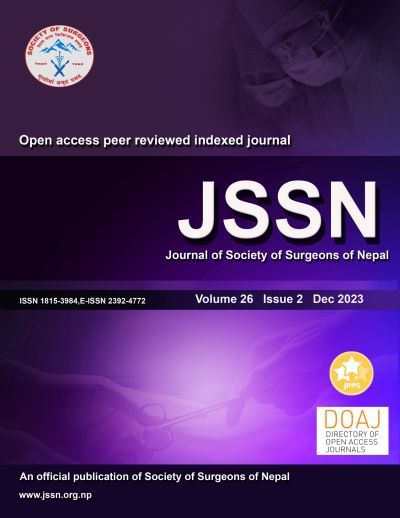Ultrasound-Guided Pneumatic Reduction of Intussusception in Children
DOI:
https://doi.org/10.3126/jssn.v26i2.63628Keywords:
Intussusception, Ultrasound, Child, EnemaAbstract
Introduction: Intussusception, occurring most commonly in 6-month to 3-year-olds, involves bowel invagination with symptoms like abdominal pain, red currant jelly stool, and a palpable mass. The preferred treatment is non-operative, especially in stable cases without contraindications. Non-operative methods include ultrasound-guided hydrostatic and pneumatic reduction, as well as fluoroscopic-guided hydrostatic reduction with barium and pneumatic reduction with air enema.
Methods: The prospective study took place at a specialized pediatric hospital over 36 months period. All children experiencing intussusception underwent abdominal sonographic assessment for diagnosis. Subsequently, an attempt was made to perform ultrasound-guided pneumatic reduction of the intussusception. Exclusions comprised hemodynamically unstable children, those displaying signs of peritonitis or bowel perforation, and those with sonographically identified pathological lead points.
Results: A total of 98 children were treated with ultrasound-guided pneumatic reduction for intussusception.The average age of the patient was 11.38±9.24 months. Ileocolic intussusception was the most common finding in 98.9%. Around 80% of the patients was presented with complaints of severe abdominal pain. In 43.8% of the patients, the duration of symptoms was less than 24 hours. The mean length of intussusception was 3.64 cm. A total of 94 (96%) children had successful reduction of intussusceptions with recurrence found in only two of cases.
Conclusion: Pneumatic reduction of intussusception is a highly effective procedure. It is associated with reduced morbidity and mortality and reduced risk of exploratory laparotomy. The main predictor for the outcome was the duration of symptoms before presentation to the institute, thus early use of pneumatic reduction is advisable.
Downloads
Downloads
Published
How to Cite
Issue
Section
License
Copyright (c) 2023 The Author(s)

This work is licensed under a Creative Commons Attribution 4.0 International License.




